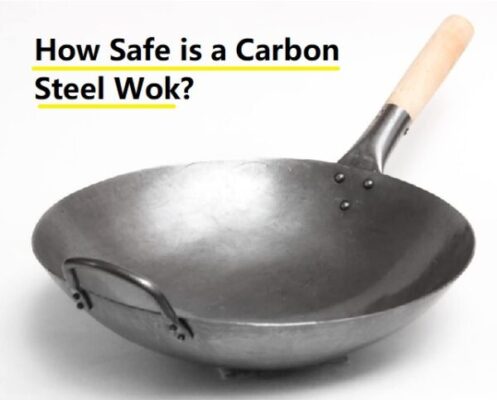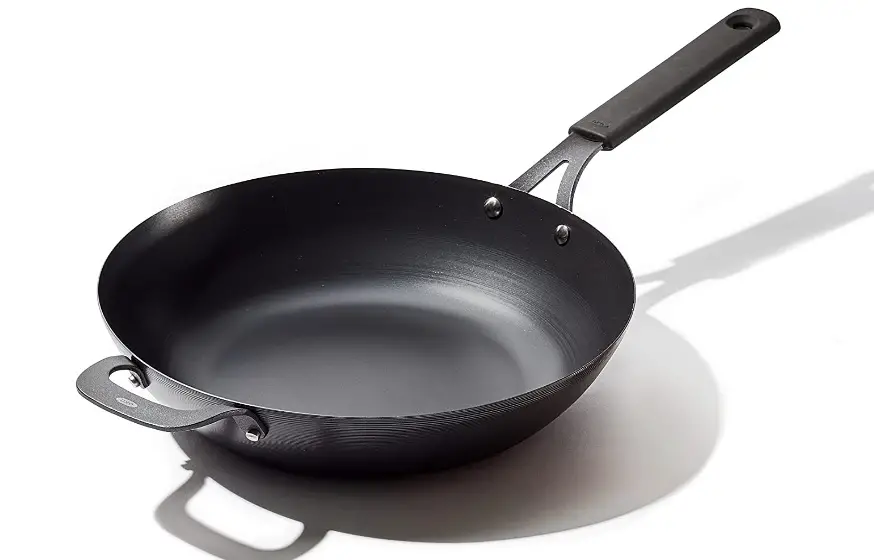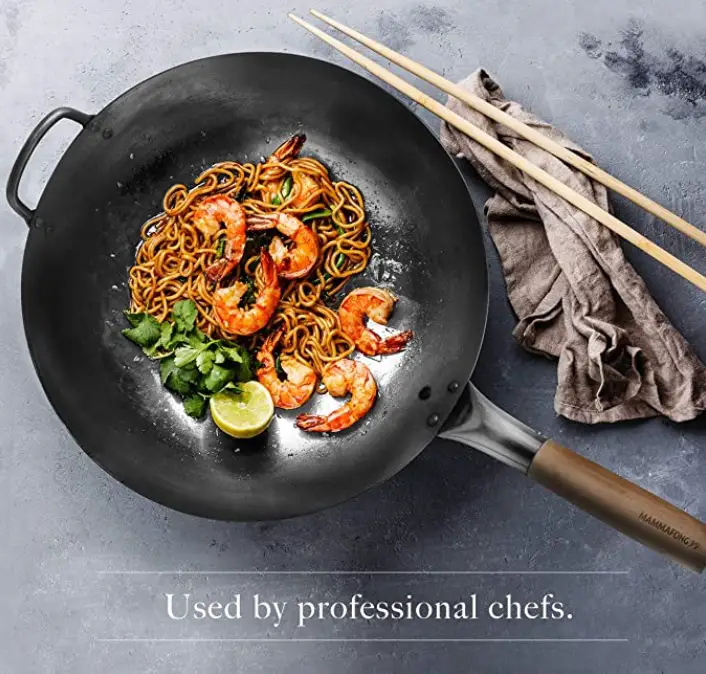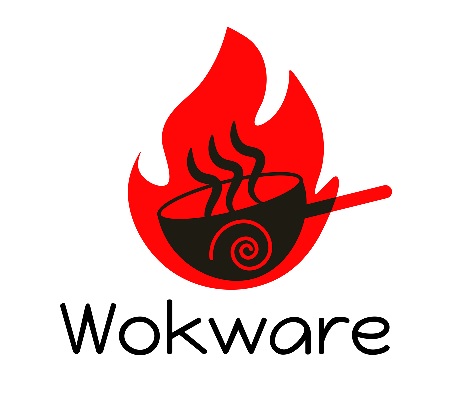Is Carbon Steel Wok Healthy?
Updated On April 2023

Wokware is reader supported. When you buy through links on our site, we may earn an affiliate commission. Learn Here.
Summary:
Carbon steel wok is very safe to use because the elements of which it is composed (iron and carbon) are good for our bodies, the composition of the wok is designed for high heat tolerance and it is naturally nonstick after seasoning.
Carbon steel is a very popular material. And there a plenty of carbon steel woks on the market. But when it comes to high-heat cooking, safety is a big concern. Certainly, we don't want to lather our food with toxic chemicals, and thus a question like 'is carbon steel wok safe?" arises. In this article, we are going to address these big safety concerns about carbon steel wok and other related FAQs.
1. Is Carbon Steel Wok Safe, Healthy or Toxic?
Carbon steel woks are highly popular for stir-frying, but recently some safety concerns have been raised about the toxicity level in the carbon steel when food is cooked on high heat. Is carbon steel wok healthy? Cooks are continuously asking this question.

Let me lay down the facts about the toxicity level of a carbon steel wok. So, as we all know, carbon steel is an alloy made from iron and carbon with small amounts of other elements such as manganese and silicon. The largest percentage that carbon steel has is iron. So people with iron sensitivity should definitely avoid using a carbon steel wok regularly.
Some might claim that proper seasoning can avoid releasing iron into your food, but there is no guarantee that your food will not be leached with iron. So what should you do? Is a carbon steel wok not safe for cooking?
Well, a carbon steel wok is very safe to use because the elements of which it is composed (iron and carbon) are good for our bodies. But scientifically, everything should be used in moderation, and so should a carbon steel wok. To avoid any kind of excessive elemental toxicity in your body, alternate your cookware and don't use a carbon steel wok regularly.




The Best Non Toxic Green Carbon Steel Wok, PFOA Free

Looking for the healthiest carbon steel wok? GreenPan has launched a green 12 inch carbon steel wok which is PFAs free, non toxic, healthy and very safe to use daily. This wok will not release any toxic chemical over high heat and is most top rated on the market in terms of functionality, durability and safety. Most importantly it is dishwasher, induction and food-safe.
Seasoning the wok properly should also be a priority in order to create an extra protective layer. Additionally, you should switch to a good food-grade stainless steel wok if you don't want to deal with the hassle of frequently seasoning your carbon steel wok. It is a much better alternative and is safe.
Another crucial tip you should follow is to always buy a carbon steel wok from a reputed brand; it ensures better safety.
2. Can you stir fry in carbon steel?
An alloy of high iron content and a minimal carbon, carbon steel is a good material for wok stir fry. Stir frying is a high-heat process and carbon steel can withstand temperatures of up to 1200 °F. Also, it is highly responsive to temperature changes, extremely durable, and a lightweight composition that makes it the perfect material to manufacture a stir fry pan. Moreover, carbon steel is suitable for any stovetop, in the oven, on the grill, and even over an open flame. However, proper seasoning and care are needed to maintain a carbon steel pan.




Pros
- lighter than cast iron
- easily responds to temperature change
- very durable on high heat
- improves over time
- affordable
- seasoning makes it nonstick
- safe to use
- traditional wok
Con
- needs care and attention
- seasoning need to be perfected
- frequent seasoning is required if used daily
- daily usage is not safe for those who are allergic to iron
- not dishwasher safe
Stir fry pan made of carbon steel is a hybrid of cast iron and stainless steel. It combines the nonstick properties and heat retention of cast iron with heat control and rapid cooking of stainless steel.
In Asia, it has long been a preferred option for stir frying. Utilizing carbon steel for a wok has a number of benefits, one of which is its quick and even heating.
Quick heating ensures the wok pan to maintain its high temperature while adding cold ingredients, which is crucial when stir-frying or searing. The adaptability of carbon steel woks is another benefit. Apart from stir-frying, you can use a carbon steel wok for deep-frying, sauteing, braising, boiling, and steaming. Carbon steel wok is preferred by chefs in both big restaurants and street counters because of its versatility and ease of cooking.
But carbon steel woks need to be kept in good shape and used for a while before they work well and don't rust. The wok is heated with oil during the seasoning process to create a non-stick coating that keeps food from sticking and aids in preventing rust. Woks made of carbon steel should also be cleaned, dried, and seasoned every so often to keep them from sticking.
3. What can you not cook in a carbon steel wok?
Carbon steel woks are a popular choice among home cooks and professional chefs mainly because of their durability, versatility, and ability to withstand high heat. Although they are great for stir-frying, sautéing, steaming, and deep-frying, there are certain foods that should not be cooked in a carbon steel wok.
Acidic Food:
While carbon steel woks are great for cooking a variety of dishes, they are not ideal for cooking acidic foods, such as tomatoes or citrus fruits. The high heat and acidity can cause the carbon steel to react and create metallic flavors in your food. If you have to cook acidic foods in a carbon steel wok, use a well-seasoned wok and refrain from cooking the food for an extended period of time.
Delicate Foods:
Carbon steel woks are great for cooking hearty vegetables and meats, but delicate foods like fish or eggs can easily stick to the pan and fall apart. Make sure to use a non-stick coating or choose a different type of pan if you want to cook delicate foods in a wok.
Boiling or simmering:
Carbon steel woks are most suitable for fast foods or cooking processes like stir frying, sauteing, deep-frying, etc. They are not intended for boiling or simmering because it can be challenging to control the temperature and keep the food from overcooking or becoming soggy due to the high sides of the wok.
Foods that require long cooking times:
Foods that require long cooking times: Carbon steel woks are best suited for quick cooking methods, as they are not well-insulated and can lose heat quickly. Foods that will take a long time to cook, such as stews or braises, are better suited for a heavy-bottomed pot like Dutch oven that can maintain a consistent temperature over a longer period of time.
Non-food items:
This may seem obvious, but it's worth mentioning that carbon steel woks should only be used for cooking food. Avoid using the wok to store or mix non-food items, as this can damage the seasoning and potentially contaminate your food.
4. Advantages of Carbon Steel in a Wok/Cookware
Carbon steel is a very popular material for a cookware mainly because it comes with a lot of conveniences. Some of the advantages of carbon steel in a wok or cookware are listed below:
Even Heating:
Carbon steel is an excellent heat conductor, meaning it heats up quickly and evenly across the surface. This results in consistent cooking and prevents hot spots that can cause food to burn or cook unevenly.
Lightweight:
Carbon steel cookware is relatively lightweight compared to other materials such as cast iron, which makes it easier to handle and maneuver in the kitchen. This can be especially important for larger pans or when cooking for extended periods.
Durable:
Carbon steel cookware is highly durable and can last for many years with proper care. It is resistant to scratches, chips, and cracks, and can withstand high temperatures without warping or degrading.
Versatile:
Non-Stick:
With proper seasoning, carbon steel cookware can develop a natural non-stick surface, making it easy to cook with and clean up. Without any toxic layer of non-stick properties, you can use a carbon steel wok safely to cook sticky food like eggs and fish.
Affordable:
Compared to other high-end cookware materials, like stainless steel, iron or copper carbon steel is affordable. Even the high end brands sell carbon steel made woks ranging from $35-$80, whereas a good stainless steel wok can cost you at least $50.
Environmentally Friendly:
As carbon steel is composed of iron and carbon, both are natural element and biodegradable. So you can easily recycle a carbon steel pan without hurting the environment.
To summarize, its even heating, lightweight design, durability, versatility, non-stick surface, affordability, and eco-friendliness make carbon steel a top contender in the world of cookware.




5. Disadvantages of Carbon Steel Wok:
Carbon steel cookware has many pros, but there are also some possible cons to think about.
Requires Seasoning:
The main drawback of a carbon steel made wok or cookware is that you need to season it properly before use. And after seasoning the wok once, you can use it 2–3 times, and the protective non-stick layer will go away after that. Clearly, if you plan to use your carbon steel pan every day, you have to season your cookware at least twice a week. Even to keep a carbon steel wok in good condition for a really long time, you need to keep seasoning it. Seasoning is a time consuming process that requires effort. Other materials do not come with this headache.
Reactive to Acidic Foods:
Carbon steel can react with acidic foods, such as tomatoes or citrus, causing a metallic taste and potentially discoloration. This can be avoided by using a well-seasoned pan or cooking acidic foods in a different type of cookware.
Susceptible to Rust:
Carbon steel is prone to rust if not properly cared for, which can lead to degradation and potentially unsafe cooking conditions. Rust can be prevented by seasoning the pan, keeping it dry and oiled, and avoiding exposure to moisture.
Can be Difficult to Clean:
Carbon steel cookware can be more difficult to clean than some other materials due to its porous surface and seasoning layer. It may require some elbow grease and special cleaning tools, such as a chainmail scrubber or coarse salt, to remove stubborn food particles or build-up.
Requires Careful Handling:
Carbon steel cookware can be delicate and prone to warping or cracking if exposed to extreme temperatures or sudden changes in temperature. It also has a thin surface that can be prone to scratching or dents if not handled carefully.
Not Dishwasher Safe:
If you are a busy person, then carbon steel might not be the right fit for you. Unlike stainless steel, this material needs serious upkeep. On the other hand, carbon steel is not at all dishwasher-safe, so you have to use elbow grease to keep it clean and germ-free. This might be bad news for many since cleaning a wok after stir frying is a nightmare if the pan is not properly seasoned.
In conclusion, while carbon steel cookware has many advantages, it also has some potential disadvantages that should be considered before making a purchase. These include the need for seasoning, reactivity to acidic foods, susceptibility to rust, difficult cleaning, careful handling, and a lack of dishwasher compatibility. However, every metal has its disadvantages. With proper care and attention, I believe carbon steel cookware can provide a reliable and high-performance option for home cooks and chefs alike.

Best Carbon Steel Wok Recommended by Wokware
Mammafong 14 inch Traditional Hand Hammered Round Bottom Carbon Steel Pow Wok Set
Faq.
Yes, you can boil in carbon steel cookware. Carbon steel is a versatile material that can be used for a wide range of cooking techniques, including boiling, frying, sautéing, and more. However, as with any cookware material, it is important to use proper precautions and techniques when boiling in carbon steel to ensure safe and effective cooking.
Here are some tips for boiling in carbon steel cookware:
- Choose the Right Size Pot: Choose a pot that is large enough to hold the amount of liquid you need without boiling over. This will help prevent spills and ensure even cooking.
- Preheat the Pot: Preheat the pot before adding the water or liquid. This can help ensure even heating and prevent hot spots.
- Use the Right Temperature: Boil the liquid at a steady temperature to prevent scorching or boiling over. This may require adjusting the heat as the liquid boils.
- Use a Lid: Use a lid to cover the pot while boiling. This can help retain heat and prevent the liquid from boiling over.
- Monitor the Liquid: Keep an eye on the liquid as it boils to prevent spills or scorching. You may need to adjust the heat or stir the liquid occasionally to prevent sticking or uneven cooking.
- Use Heat-Resistant Utensils: When handling the pot or stirring the liquid, use heat-resistant utensils to prevent burns or damage to the pot.
Overall, boiling in carbon steel cookware is safe and effective when done correctly. Just be sure to follow proper precautions and techniques to ensure even heating, prevent spills, and avoid damage to the pot or injury to yourself.
Yes, you can use lemon in carbon steel, but if you don't take precaution, it might react with the iron in the carbon steel and cause discoloration in the cookware. Seasoning the cookware well before cooking lemon or acidic food in a carbon steel pan will protect your food and the pan from damage.
If you still want to use lemon in carbon steel cookware, here are some tips to keep any reactions to a minimum:
Use a well-seasoned pan: The seasoning on a carbon steel pan can help create a protective layer that reduces the risk of acidic foods reacting with the iron. Follow the manufacturer's instructions on how to season and clean your pan to keep the seasoning in good shape.
Cook for a short amount of time: If you are following a recipe where you need to cook the acidic item, in this case lemon, for a longer period, you need to cut the time short. Check if it can be added to the recipe where the remaining cooking time is less. This will guarantee the safety of your food and cookware.
Clean the pan thoroughly: After using lemon in your carbon steel pan, be sure to clean the pan thoroughly to remove any remaining acidic residue. This can help prevent discoloration and other issues that the acidic food might create.
To summarize, if you follow the proper safety standards for cooking acidic food in carbon steel, you can easily use a lemon in it.
Yes, you can certainly cook onions in carbon steel cookware. Carbon steel pans are a great choice because they allow you to get a nice sear on the onions and cook them evenly. But make sure to season the cookware with oil, following the instructions from the brand, to get that nonstick surface so you can cook onions without sticking.
Here are some tips for cooking onions in carbon steel cookware:
Preheat the pan: Before adding the onions, preheat the carbon steel pan over medium-high heat. This helps ensure even cooking and prevents sticking.
Use enough oil: Adding enough oil to the pan can help prevent the onions from sticking and ensure even browning. Seasoning the carbon steel effectively is also the key to not sticking your onion to the pan.
Cut the onions evenly: Cut the onions into even slices or pieces to ensure they cook evenly. If the onions are cut unevenly, some pieces may cook faster than others and become burned or mushy.
Stir the onions frequently: Stir the onions frequently to prevent them from sticking and ensure they cook evenly. You can use a good spatula dedicated to a carbon steel wok to stir the onions gently.
Yes you can use tomato sauce in a carbon steel cookware. But make sure to take care of these three things before cooking. First seasoning the carbon steel pan is the most important part to create a protective nonstick layer, second use the tomato sauce over heat for as limited time as possible so that the iron in the carbon steel doesn't get enough time to react with the sauce, and finally use a wooden spatula to cook or stir the food for additional safety.
Carbon steel wok in general is safe to use or cook but if you have a medical history of iron toxicity or hemochromatosis, adding iron to the diet might cause a problem. And as carbon steel has high content of iron, you should avoid carbon steel cookware or wok altogether.
Carbon steel contain high percentage of iron but the amount of iron that is actually leaching to food while cooking is insignificant. In fact, you would need to use a carbon steel pan on a daily basis for several years in order to get the same amount of iron from your diet that you would get from eating a single serving of spinach. So while there is a small risk of iron leaching from carbon steel wok pans, it is not likely to pose a significant health concern. But people with iron toxicity should avoid carbon steel.
Carbon steel contain high percentage of iron but the amount of iron that is actually leaching to food while cooking is insignificant. In fact, you would need to use a carbon steel pan on a daily basis for several years in order to get the same amount of iron from your diet that you would get from eating a single serving of spinach. So while there is a small risk of iron leaching from carbon steel wok pans, it is not likely to pose a significant health concern. But people with iron toxicity should avoid carbon steel.
Author: Preeunka
Editor at Wokware
She is an expert in the niche of kitchenware for 10 years now. She has given readers fact based, well researched, to the point answers of their valuable questions. Her goal is to simplify kitchen products and their utilities.
